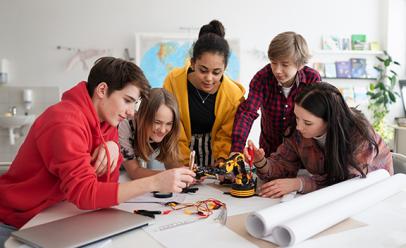 By: Kendall Hunt RPD Editorial and Development Team
By: Kendall Hunt RPD Editorial and Development Team
Project-based learning (PBL) is an effective way of teaching that lets students become the directors of their own learning and the teacher becomes the guide on the journey to discovering the solutions to an essential question within a proposed project. PBL is the act of learning through identifying a real-world problem and developing a corresponding solution. Students show what they learn as they move through a new and engaging project.
From our curriculum development experience, we know that PBL is beneficial for student learning. A more complete explanation of PBL is that it is the ongoing act of learning about different subjects simultaneously. This is achieved by guiding students to identify, through research, a real-world problem (locally or globally), develop a solution using evidence to support the claim, and present the solution to others in the classroom.
Along with inquiry science and other student-centered methods of teaching, PBL has become all the rage these past few years. Research indicates that students are more likely to retain the knowledge gained through this approach far more readily than through traditional textbook-centered learning.
Science seems like the logical subject to apply this type of teaching style to, but this can also be applied to language arts, math, and social studies. For students working on strengthening their reading skills, you can have them work with a group to conduct a reader’s theater, acting out what they are reading or even what they have written. Math students can use manipulatives to work out problems. In social studies, students can develop their own maps, or create models of what they are learning about.
You’ve seen the articles on how to get started and the list of perfect projects. And you know you should be jumping in with both feet, but are you secretly wondering … So, how is one specific project teaching my students the overall content? It’s a fair question. After all, for one specific project, it might seem that students learn to use a concept or skill in only that one specific way. But nothing could be further from the truth.
Because of their open-ended nature, PBL projects help kids apply content in a variety of ways and here are for examples:
1. PBL asks students to connect prior knowledge and skills as they begin the project.
Worksheets can feel like, “no-prior-experience-necessary” environments, with all the skills needed to solve the problems provided on the paper. Worksheets help students practice skills—but in isolation, without linking them to pre-existing knowledge. With a PBL project, where there are no templates or exact answers, students must use what they already know. Initial decisions must be made to move the project forward, and those decisions are based on prior experience. This helps students make connections between what they already know and what they’re learning, reinforcing content by giving it more “hooks” and connections in their memory.
2. To complete the project well, students are encouraged to learn the content.
Yes, it’s possible for students to “guess and check” their way through some projects without learning the content, but not if they want to do it efficiently. In Johnny Devine’s AP Physics class, students built model Mars rovers in an expanded egg-drop experiment while learning about terminal velocity, surface area, and air resistance. If the students didn’t learn how to quantify and combine these variables, they wouldn’t know the best way to build a rover or understand how to test it and what to look for. PBL isn’t a “fun way out” of learning because learning is essential for doing well on the project.
3. PBL requires fine-tuning and fixing.
As students work on a project, they adapt their ideas based on new research they uncover, new data they observe, or new discussions they have. They often must fix problems that arise in their designs or experiments—and to fix something, students must be able to understand how it works. Plus, the more students tinker with their projects, the more exposure they have to the material. Students will need to repeat the equations repeatedly with different trials just being able to use that math over and over again helps it stick.
4. PBL reinforces the concept.
On a worksheet, directions tell students when to solve for the derivative, divide the word into syllables, or find the terminal velocity. They don’t need to figure out what they should be looking for. They don’t need to understand when or why to use this equation and not that one. Traditional learning teaches students the skill, not the situation in which the skill is used.
But in an open-ended project, learners must figure out which equation gives them the information they need—not to mention figuring out what information they need in the first place. And because students must figure that out, they get a more accurate understanding of the information that equation is giving them. The student will understand the equation rather than just knowing how to do it.
In conclusion, that’s why PBL works—it helps students understand the why and when, not just the how. With open-ended PBL projects, students don’t just learn information, but they are learn why they’re learning it, and that makes all the difference.
When have you seen the power of project-based learning in your classroom?
Sources:
https://www.edutopia.org/video/projects-work-mission-mars
https://www.edutopia.org/video/anatomy-project-kinetic-conundrum
https://www.edutopia.org/blog/20-ideas-for-engaging-projects-suzie-boss
https://www.teachthought.com/project-based-learning/a-better-list-of-ideas-for-project-based-learning/
https://www.edutopia.org/article/new-study-shows-impact-pbl-student-achievement-nell-duke-anne-lise-halvorsen
https://www.edutopia.org
rning in your classroom?/blog/project-based-learning-getting-started-basics-andrew-miller